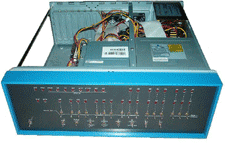Gifts for an Eight-Bit Holiday
Trying to find a gift for the geek who has everything? A wide variety of rare and classic computers is now available in replica-kit form, perfect for rekindling digital memories.

Original models of computers like the Apple I, the MITS Altair, and the Enigma coding machine are hard to find and often sell for several thousand dollars each at hobbyist events and on eBay. Modern replica versions, however, only cost a few hundred dollars or less.
These classic-computer replicas aren’t just passive models, either. They’re functional tools that can be used the same way they were 30 or 40 years ago: write your own programs in BASIC; chat on an old-fashioned bulletin-board service; and, of course, play low-resolution and text-based games. Just as car lovers take their antiques out for special events, revel in camaraderie at summertime shows, and enjoy the satisfaction of at-home repair, so, too, can vintage-computer hobbyists. New computers might outperform the old ones, but the old ones have a lot of personality compared with boring beige boxes.
“In the 1970s you had the Homebrew Computer Club,” says Sellam Ismail, founder of the Vintage Computer Festival. “Those are the baby boomers of the computer world. Now they’re passing on their love of technology and making stuff [for] the next generation.” The weekend convention is held every fall at the Mountain View, California-based Computer History Museum. The event includes exhibits, lectures, sales, and workshops featuring computers from the 1950s through the 1980s. Regional editions happen throughout the year.
The newest offering is VintageTech’s Linux-powered reproduction of the legendary Digital Equipment Corp. PDP-1 minicomputer. There are free online emulators, but that won’t give you the full experience. In the early days of computers, many machines featured a panel of blinking lights, or “blinkenlights,” in geek parlance. This model doesn’t disappoint. You could program the computer to teach your child algebra, but it’s far more festive to play the 1961 classic game SpaceWar! First developed by MIT artificial-intelligence researcher Steve “Slug” Russell, SpaceWar! is widely considered the first two-player digital computer game.
Mac lovers might enjoy the Replica 1, a clone of the 1976 Apple I. The Replica 1 only costs $160–a sweet deal when you consider that the original Apple I can cost as much as $25,000 at auction. Replica 1 boards aren’t full cosmetic clones, but their functionality is identical, the sole deviation being an optional adapter for a modern keyboard. Steve Wozniak’s original software is built-in.
Those who really love to tinker might prefer an Altair. Featured on the now-famous cover of the January 1975 issue of Popular Electronics, the Altair is often cited as the machine that started the personal-computing revolution. Bill Gates and Paul Allen worked with Altair before they launched their Albuquerque startup company Microsoft. Briel Computers is taking preorders for its AltairPC, a PC case that makes a typical desktop computer look just like a 1975 MITS Altair 8800. Collector Rich Cini also makes Altair-style PC covers, but Cini’s is a front-panel cover with a plug-in board that connects the panel to your PC. Download the free Altair32 emulator software, and you can explore the original functionality. A full-scale, fully operational version of the Altair will soon be available through Grant Stockly. That kit isn’t officially priced yet, but it won’t surpass $1,700, Stockly says.
For something a little more exotic, you could give someone a fully electronic $235 Enigma-E or a $10 Paper Enigma, the latter being well suited for children. Both can make and break codes with historical accuracy. Also good for children is the Digi-Comp I v2.0, which costs just $55. It’s an amazing computational trainer that anyone can build in an afternoon.
Tore Bekkedal, a collector from Oslo, Norway, says the various replicas are good news for common hobbyists like him. “They replicate not only the fascinating technology, but also the tinker spirit,” he says. “It also helps preserve the software and the knowledge of how to work it.”
Keep Reading
Most Popular
Large language models can do jaw-dropping things. But nobody knows exactly why.
And that's a problem. Figuring it out is one of the biggest scientific puzzles of our time and a crucial step towards controlling more powerful future models.
The problem with plug-in hybrids? Their drivers.
Plug-in hybrids are often sold as a transition to EVs, but new data from Europe shows we’re still underestimating the emissions they produce.
How scientists traced a mysterious covid case back to six toilets
When wastewater surveillance turns into a hunt for a single infected individual, the ethics get tricky.
Google DeepMind’s new generative model makes Super Mario–like games from scratch
Genie learns how to control games by watching hours and hours of video. It could help train next-gen robots too.
Stay connected
Get the latest updates from
MIT Technology Review
Discover special offers, top stories, upcoming events, and more.